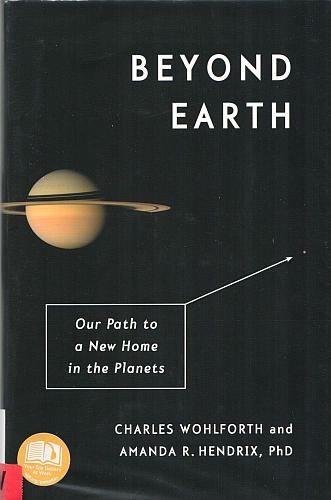

| BEYOND EARTH Our Path to a New Home in the Planets Charles Wohlforth Amanda R. Hendrix, Ph.D. New York: Pantheon Books, November 2016 |
Rating: 5.0 High |
|||
| ISBN-13 978-0-8041-9797-7 | ||||
| ISBN-10 0-8041-9797-0 | 321pp. | HC/BWI | $27.95 | |
Few people who followed NASA's Apollo and space shuttle missions avidly are satisfied with its performance in advancing our ability to travel in space. The authors certainly are not satisfied. In addition, they understand that several inconvenient truths need to be acknowledged — the reality of climate change being only one among them.
"It would be far easier and less expensive to protect the Earth than to move people to another planet. But no one on Earth has the power to make that decision. Individual nations and even wealthy people could advance the future of space travel to move outward, but to halt carbon emissions would require cooperation by the entire species. "If we assume that humanity doesn't change its path, what might happen? That question has guided our exercise in drawing a scenario of space colonization, even at the risk of asking embarrassing questions that many scientists avoid. We would certainly save this planet first, given the choice. But, in case humanity does not, we've dared consider the next human migration." – Page 25 |
In propounding their scenarios, they follow the lead of several previous writers, including Dr. Chris Impey and Apollo astronaut Mike Collins,1 by interspersing a factual explanation of the state of the art with fictional episodes illustrating a vision of where those developing capabilities might lead us in the near future.
There is no lack of opinions on where humans ought to go next in space flight, or how they ought to get there. One faction wants Mars to be that next destination; another prefers the Moon, on the basis that it is relatively easy to reach and could facilitate voyages farther out. The authors propose a novel idea: that space settlers should go to Titan, a large moon of Saturn. They reason that its thick atmosphere will shield residents against cosmic rays and that it contains resources useful in maintaining life: water, carbon and nitrogen.
One thing most advocates of human spaceflight agree on is the need to lower the cost of launches from Earth. The authors also agree, and they devote a chapter to examining Elon Musk's company SpaceX, which is making good progress in achieving that goal. They correctly point out that lower-cost access to space will permit a wide variety of activities there, including on-orbit construction of large vehicles and rotating space stations — and that NASA, despite many promises, has failed to achieve sufficient cost reduction.
"The need for an inexpensive, reusable space vehicle has been the obvious next step for forty years, ever since the conception of the space shuttle. An inexpensive shuttle into space would allow large structures to be built there, including massive vehicles that could go to other planets, and cost-effective space businesses of unimagined kinds. NASA sold the space shuttle to Congress in 1972 with claims that it would fly up to fifty times a year, launching payloads for under $100 a pound, and predicted a 10 percent return on investment. When the program ended in 2011, NASA had spent $192 billion on 133 successful flights with a payload cost per pound (if every shuttle had been at capacity) of about $30,000." – Page 16 |
However, in my opinion they fall short when it comes to methods of propulsion. They focus on the Q-Drive, proposed by Harold "Sonny" White, which so far is little more than a concept. They mention ion drives, as used on the Dawn spacecraft. But there is no discussion of the VASIMR engine which Franklin Chang-Diaz is developing on a shoestring, of NERVA, a nuclear rocket engine developed and ground-tested in the 1960s, or of former NASA administrator Sean O'Keefe's Project Prometheus — a 2003-2005 program to develop nuclear-electric propulsion systems.
But there is much of benefit in this book, starting with the novel (to me) idea of settling Titan and the well-described plan of execution (with the generous assumption that the Q-Drive will work.) Next there is the forthright discussion of problems humans face during long periods in low gravity, including newly discovered eye problems. It is clear that keeping humans healthy on long-distance space voyages remains a formidable problem, requiring much improvement in hardware systems as well as extensive medical research.

 To contact Chris Winter, send email to this address.
To contact Chris Winter, send email to this address.